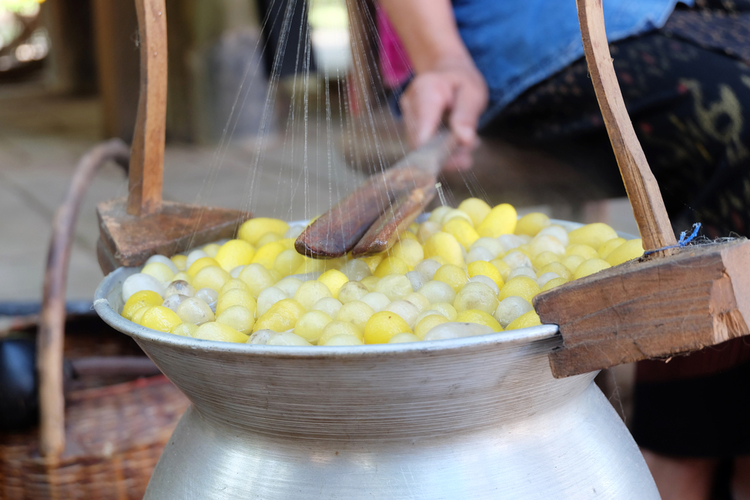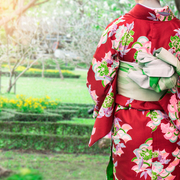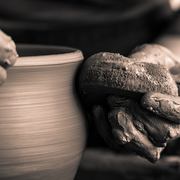Sericulture is an industry producing silk from cocoons produced by silkworms, insects of bombycidade.
Sericulture farmers cultivate mulberries to feed larvae of silkworms.
On the process of growing, once larvae turn to chrysalises, they produce cocoons.
Silk is produced from fibers of cocoons.
During the Meiji and the early Showa period(1868- around 1910s), sericulture farmers shipped out cocoons to silk mills.
In the mill, after drying, boiling and softening cocoons, thin strings are pulled out from them. Reeling strings with twisting makes silk.

All cocoons which is not used for products and silkworms after extraction, were reused.
For example, chrysalises after extraction were used to feed carps, and be eaten in the soy sauce-boiled as valuable source of protein, in Nagano.
People used silkworms entirely.
At the peak period, sericulture were seen across the country, but the flourished areas by silkworms were especially called as “Santo (silkworm capital)” and “Souto (mulberries capital).
History of Silk
Sericulture was born in China around 15th century B.C, and spread to Europe.
It is said to be introduced to Japan in the 1st to 2nd century.
Silk was regarded as special luxury goods because of its unique soft texture and beautiful sheens, and it was presented as gifts to the authorities.
In the countries of Mediterranean Sea, merchants head to China seeking for silk exchanging with wools, gold and silver.
The trade routes those merchants used to cross Central Asia was so called “Silk Road”.
In the Edo period (1603-1867) of Japan, sericulture came to get flourished. Fukushima, Gunma and Nagano prefecture were famous for its production.
After Perry from United States visited Japan and trading began, silk came to be exported.
Silk industry grew to occupy 60% of the total amount of export in the Taisho and early Showa period.
It is no exaggeration to say that silkworm undertook a significant role for development in Japan.
That led people in the key areas of sericulture to call important silkworms as “Oko-san” or “Kaiko-sama” to pay their respects.

However, the war and the appearance of chemical fibers drove sericulture industry to decline.
There were the 2.21 million of sericulture farmers in 1929. Recently its number was dropped to 350.
Life of Silkworm
Silkworms cannot be found in the wild, but were domesticated artificially.
More than 5000 years ago, it was said to be born by breeding the insects called Kuwako in China.
Silkworms are not active and its larvae do not run away.
The wings are degenerated and the adults cannot fly.
Silkworms are the insects which cannot survive without human cares.
Silkworms grow through 4 times of shedding after incubation.
Larvae grow fast and eat lots. It is said that, when many of larvae were fed at once, the sounds like raining echoed throughout.
Larvae have 2 mouths, one for eating and the other for extruding a fiber, and it starts producing cocoons after growing up to the size of around 65-85mm.
After moving to the place called “Mabushi” that has rooms with the size of 40mm×50mm×20mm high, silkworms produce cocoons with the size of 20mm×30-35mm by extruding fibers around themselves taking 2-3 days.
Around 4 days after, it starts shedding inside a cocoon and turns brown in 10 days, which is a chrysalis.

At this point, it is shipped to produce silk. If it grows to emerge, it becomes Kaikoga (silkworm moth) with the size of 4cm.
Its body is pure-white with velvelt-like texture and looks lovely with the round and fat shape.
After excreting (called Ganyo) twice, female silkworm moths release a pheromone and the male looks for it by using tentacles.
After mating, female silkworm moths keep laying eggs for about 3 days.
The number of eggs is 500-700.
During laying, it does not eat anything.
This is because the mouth of the adults is degenerated and it cannot eat.
2 weeks after that, a life of a silkworm moth ends. Its whole life is short and has only 1.5 months.
Having cocoons in the short cycle makes it possible to produce silk stably.
Characteristics of Silk
Silk is made of fibroin, protein fiber, and sericin, water-soluble protein, which creates uniquely mellow sheens.
It also has high moisture retention, absorbency, and breathability.
As it has soft texture and is easy on skin, it is often used for underwear, which touches skin directly.
As it is natural material, it can be said that it is eco-friendly contributing to reduce greenhouse gas emissions.
Silk products of Japan
Textile and Kimono maybe the first to come into your mind as silk products of Japan.
Silk is the material colors more vividly than hemp, cotton and chemical fibers on dying, not only with its soft texture and sheens.
Blending silk materials and craftsmanship create delicate silk textile products in Japan such as Nishijin-ori in Kyoto, Yuki-tsunugi in Ibaraki.
However, now that the demand of traditional Kimono has been decreasing, new uses of silk have gained attention.

In 2000, National Institute of Sericultural and Entomological Science, Ministry of Agriculture, Forestry and Fisheries, invented silk fibers illuminating in 11 colors like green, red, orange.
It made headlines that illuminating dress is produced experimentally.
Moreover, in the medical field, silkworms are utilized to produce antibodies and vaccine, and silk fibers are used to sutures on surgery.
Also its moisturizing capacity are used for cosmetics, which have been distributed as merchandise.
The fields to make the use of silk have been expanding such as for musical instruments, art supplies, condensers for audio equipment to improve sound quality.
The more studies have made progress on various usages such as detection of drug, molds on food, toxic substances, diseases, or substitution of experimental animals like mice.
These can be possible by genetic recombination techniques.
By steady progress on modern techniques and researches, silkworms will improve our lives more.
Today’s Sericulture
Today, sericulture industry has been declined to the critical phase in Japan compared with the time of peek.
However, globally-speaking, the demand of silk has been growing because of its high potential. According to the statement of the US research company, its demand has been developing by 7.8% annually since 2016.
As the production amount has been decreasing in China, Vietnam, Brazil, where hold sericulture, the price of silk is assumed to get higher worldwide.
That leads some areas to work on restoration and revitalization of sericulture taking into consideration of global markets.
In 2017, in Kumamoto, the world’s biggest bio-clean sericulture facility “NSP Yamaga Mill” was established.
The state-of-art facilities are introduced to produce silk stably at year-around bio-clean environment.
it aims to improve the brand value of Japanese silk, to create job opportunities, and to vitalize regions.
In Ehime, “Council to Rejuvenate Iyo Raw silk Production areas” was organized to focus on recruiting newcomers to sericulture.
Fortunately, Iyo row silk was registered by GI (Geographical Indication) system, which is the government certification, which assured the industry and the brand would be protected.
In Gunma, in 2014, Tomioka Silk Mill and Related Sites was registered on the UNESCO World Heritage list, and “Gunma Sericulture School” was opened to train successors.
Actually, the graduates from the school join in sericulture industry, which proves the industry is reviving.
Tomioka Silk Mill in Gunma was the government-owned mill by instruments formed in the Meiji period. It is said that it had 300 boiling pot for cocoons.
At that time, it was the largest-scale mill in the world.
It is the valuable heritage that teach us the great history of sericulture which supported Japan.
Why don’t you get closer to the sericulture culture many people have preserved over the history?
Once you understand its greatness, you cannot help calling silkworms “Oko-sama” to show your respects.

















